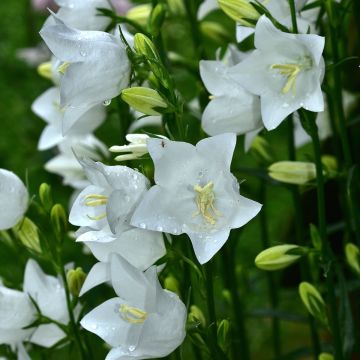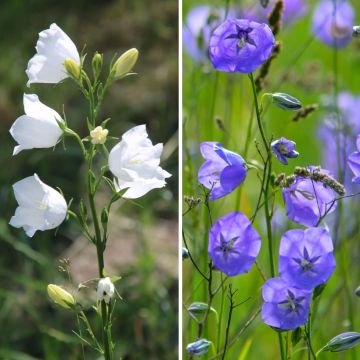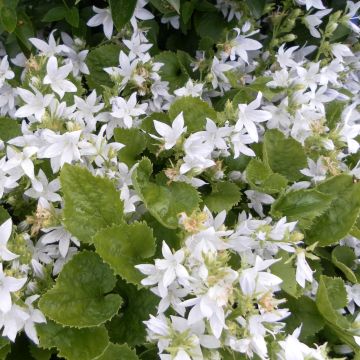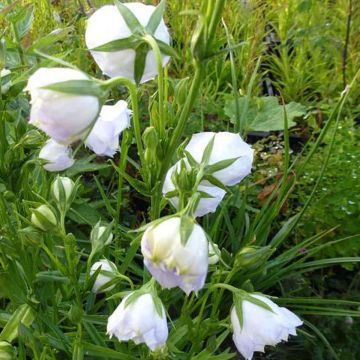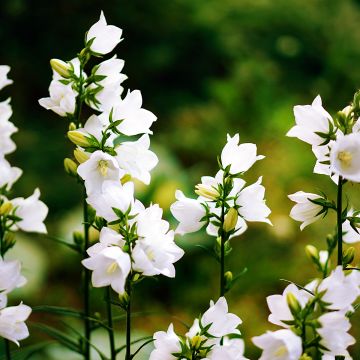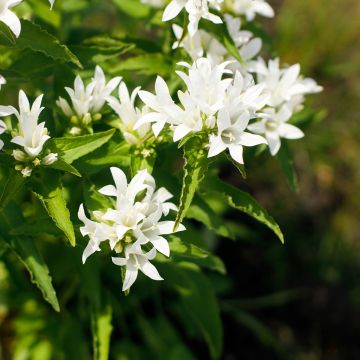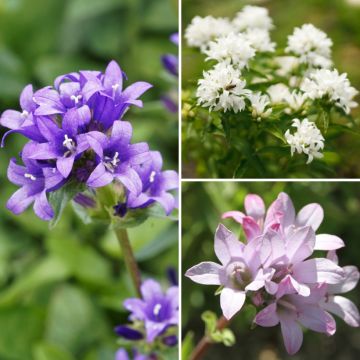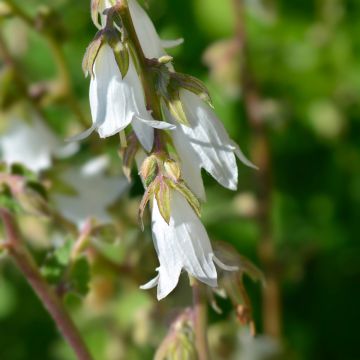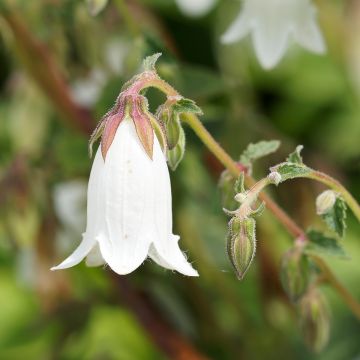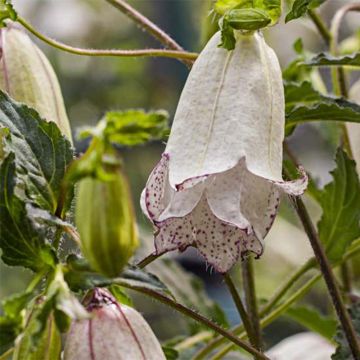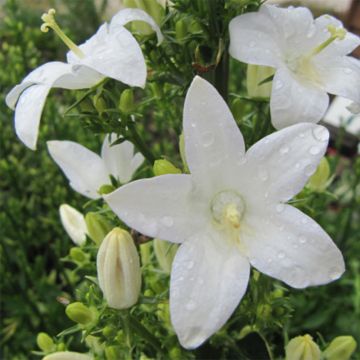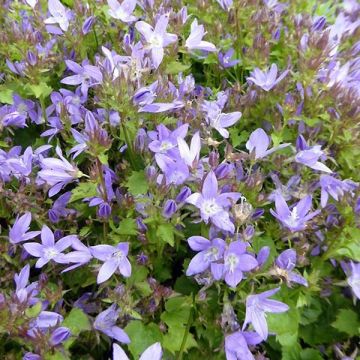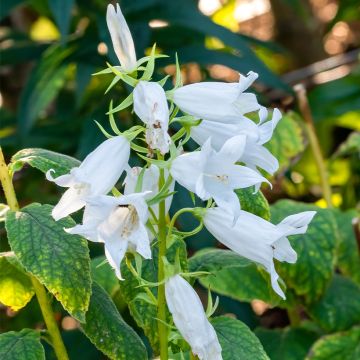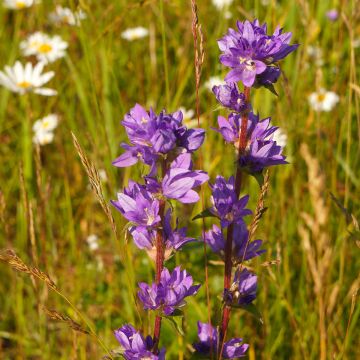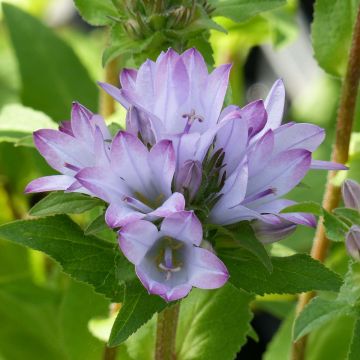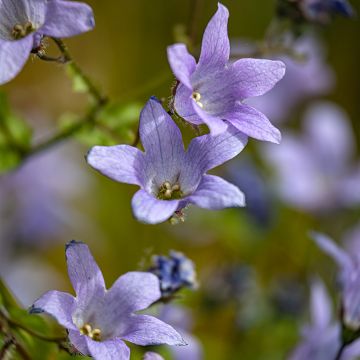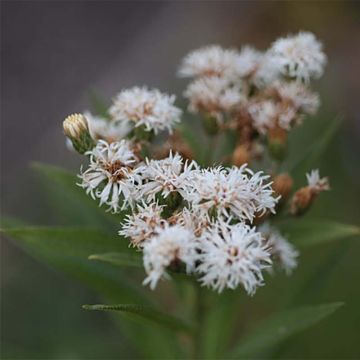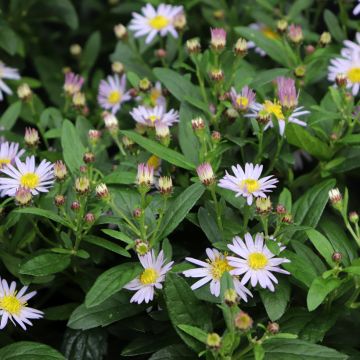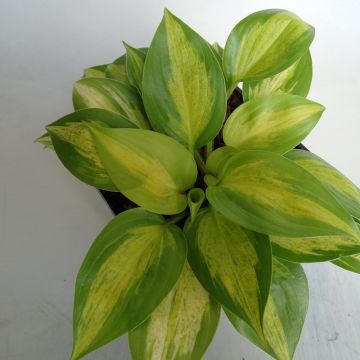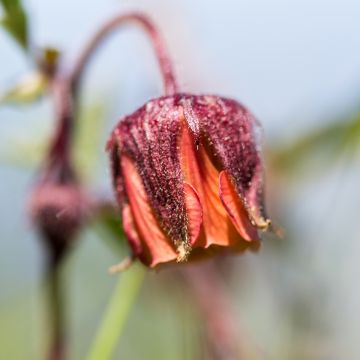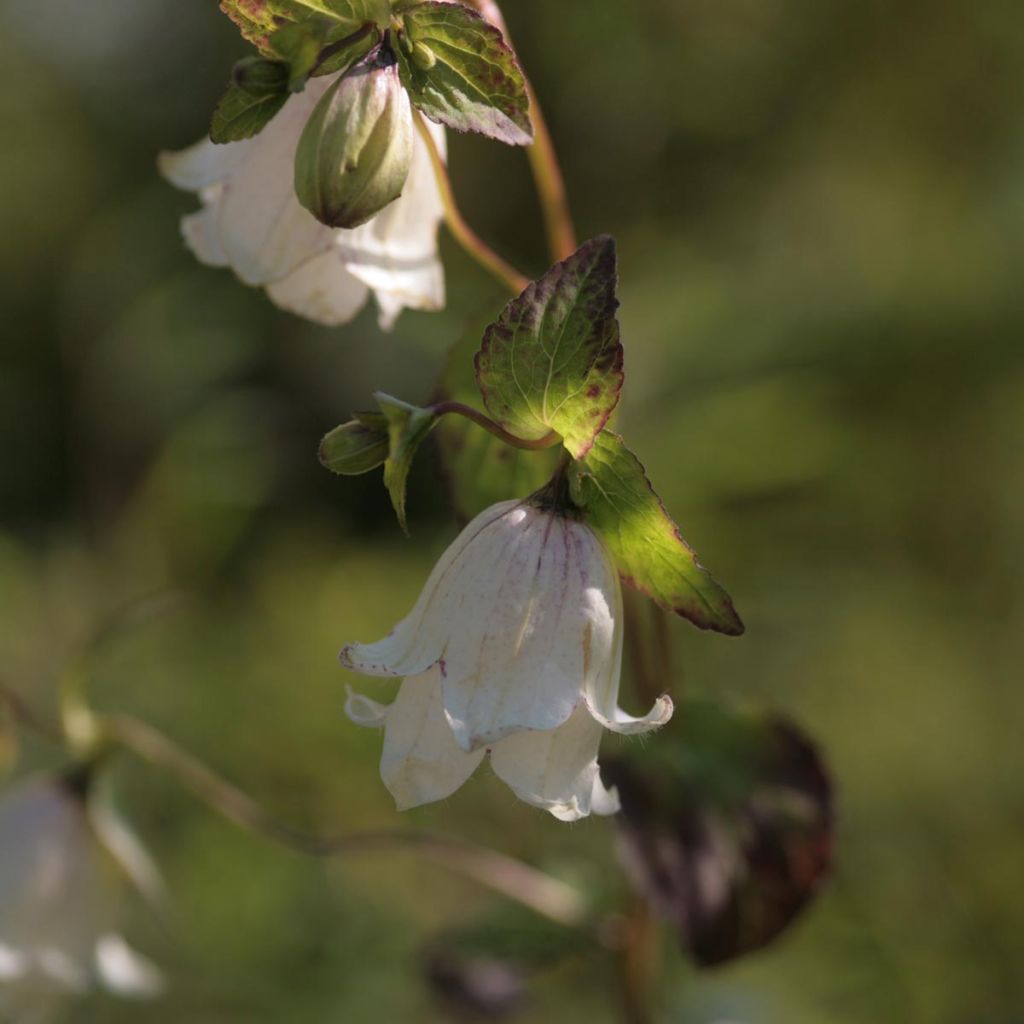

Campanula punctata Wedding Bells
Campanula punctata Wedding Bells
Campanula x punctata 'Wedding Bells'
harebell
I received a call informing me that this young plant was not of optimal quality. I appreciated your seriousness.
Elsa L., 16/10/2018
Why not try an alternative variety in stock?
View all →This plant carries a 12 months recovery warranty
More information
We guarantee the quality of our plants for a full growing cycle, and will replace at our expense any plant that fails to recover under normal climatic and planting conditions.
From €5.90 for pickup delivery and €6.90 for home delivery
Express home delivery from €8.90.
Does this plant fit my garden?
Set up your Plantfit profile →
Description
Campanula punctata 'Wedding Bells' is a refined and bushy variety of bellflower. Throughout the summer, it bears semi-double and pendulous bell-shaped flowers. The corolla is cream-white with a hint of pink. The contrast with the rather dark foliage, makes the flowers appear even brighter. It is also interesting for its spreading habit, making it a good ground cover in borders. It is a beautiful romantic plant that deserves to be displayed prominently, in a cottage-style flower bed for example.
The genus Campanula belongs to the family of bellflowers. 'Wedding Bells' is a horticultural selection derived from C. punctata, a species native to Korea. This variety has a clump-forming size of 40 cm (16in), spreading through short underground rhizomes from which the erect and leafy stems arise. In early summer, beautiful bell-shaped flowers begin to appear, inclined towards the ground and measuring 5 cm (2in) in length. The corolla is double as if the flowers were wearing a skirt and petticoat, adding to the refinement of their delicate white colour, slightly tinged with pink at the base. They continue to bloom until September if the faded stems are removed. The foliage is deciduous, but persists for a long time before disappearing. It is dark green, ovate, dentate, and slightly hairy leaves.
'Wedding Bells' bellflower is easy to grow and likes sunny exposures and rich, well-draining soils. When happy, it produces suckers from its base, although its medium growth rate means it is not invasive. In a wild or romantic style garden, it can be paired with grasses like melica, perennial geraniums, English roses, and ornamental alliums. It also performs well in containers. Its flowering stems are perfect for bouquets.
Report an error about the product description
Campanula punctata Wedding Bells in pictures
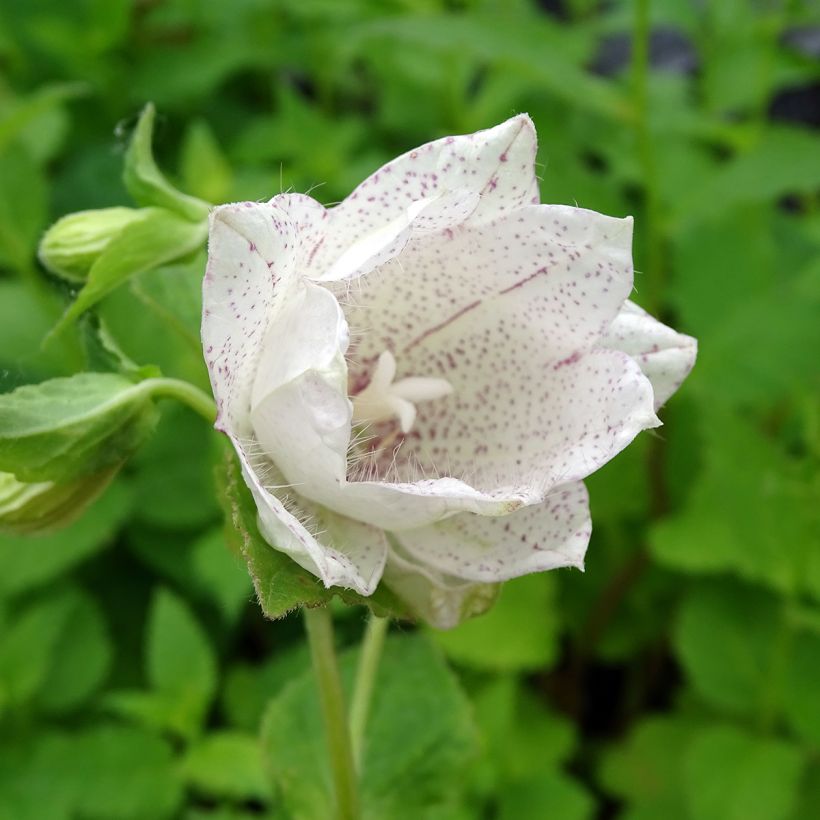



Flowering
Foliage
Plant habit
Botanical data
Campanula
x punctata
'Wedding Bells'
Campanulaceae
harebell
Cultivar or hybrid
Other Campanula - Bell Flower
Planting and care
Plant Campanula punctata 'Wedding Bells' in full sun or partial shade, in rich and moist soil, even limestone, well-drained and deeply dug. In heavy soil, incorporate leaf compost into the planting soil. Do not be guided by the size of the young plant in the pot, make sure it has space to spread. You must cut back the stems after flowering to promote the emergence of new flowers. In pots, apply organic fertilizer at least once a year.
Planting period
Intended location
Care
-
, onOrder confirmed
Reply from on Promesse de fleurs
Summer flowering perennials
Haven't found what you were looking for?
Hardiness is the lowest winter temperature a plant can endure without suffering serious damage or even dying. However, hardiness is affected by location (a sheltered area, such as a patio), protection (winter cover) and soil type (hardiness is improved by well-drained soil).

Photo Sharing Terms & Conditions
In order to encourage gardeners to interact and share their experiences, Promesse de fleurs offers various media enabling content to be uploaded onto its Site - in particular via the ‘Photo sharing’ module.
The User agrees to refrain from:
- Posting any content that is illegal, prejudicial, insulting, racist, inciteful to hatred, revisionist, contrary to public decency, that infringes on privacy or on the privacy rights of third parties, in particular the publicity rights of persons and goods, intellectual property rights, or the right to privacy.
- Submitting content on behalf of a third party;
- Impersonate the identity of a third party and/or publish any personal information about a third party;
In general, the User undertakes to refrain from any unethical behaviour.
All Content (in particular text, comments, files, images, photos, videos, creative works, etc.), which may be subject to property or intellectual property rights, image or other private rights, shall remain the property of the User, subject to the limited rights granted by the terms of the licence granted by Promesse de fleurs as stated below. Users are at liberty to publish or not to publish such Content on the Site, notably via the ‘Photo Sharing’ facility, and accept that this Content shall be made public and freely accessible, notably on the Internet.
Users further acknowledge, undertake to have ,and guarantee that they hold all necessary rights and permissions to publish such material on the Site, in particular with regard to the legislation in force pertaining to any privacy, property, intellectual property, image, or contractual rights, or rights of any other nature. By publishing such Content on the Site, Users acknowledge accepting full liability as publishers of the Content within the meaning of the law, and grant Promesse de fleurs, free of charge, an inclusive, worldwide licence for the said Content for the entire duration of its publication, including all reproduction, representation, up/downloading, displaying, performing, transmission, and storage rights.
Users also grant permission for their name to be linked to the Content and accept that this link may not always be made available.
By engaging in posting material, Users consent to their Content becoming automatically accessible on the Internet, in particular on other sites and/or blogs and/or web pages of the Promesse de fleurs site, including in particular social pages and the Promesse de fleurs catalogue.
Users may secure the removal of entrusted content free of charge by issuing a simple request via our contact form.
The flowering period indicated on our website applies to countries and regions located in USDA zone 8 (France, the United Kingdom, Ireland, the Netherlands, etc.)
It will vary according to where you live:
- In zones 9 to 10 (Italy, Spain, Greece, etc.), flowering will occur about 2 to 4 weeks earlier.
- In zones 6 to 7 (Germany, Poland, Slovenia, and lower mountainous regions), flowering will be delayed by 2 to 3 weeks.
- In zone 5 (Central Europe, Scandinavia), blooming will be delayed by 3 to 5 weeks.
In temperate climates, pruning of spring-flowering shrubs (forsythia, spireas, etc.) should be done just after flowering.
Pruning of summer-flowering shrubs (Indian Lilac, Perovskia, etc.) can be done in winter or spring.
In cold regions as well as with frost-sensitive plants, avoid pruning too early when severe frosts may still occur.
The planting period indicated on our website applies to countries and regions located in USDA zone 8 (France, United Kingdom, Ireland, Netherlands).
It will vary according to where you live:
- In Mediterranean zones (Marseille, Madrid, Milan, etc.), autumn and winter are the best planting periods.
- In continental zones (Strasbourg, Munich, Vienna, etc.), delay planting by 2 to 3 weeks in spring and bring it forward by 2 to 4 weeks in autumn.
- In mountainous regions (the Alps, Pyrenees, Carpathians, etc.), it is best to plant in late spring (May-June) or late summer (August-September).
The harvesting period indicated on our website applies to countries and regions in USDA zone 8 (France, England, Ireland, the Netherlands).
In colder areas (Scandinavia, Poland, Austria...) fruit and vegetable harvests are likely to be delayed by 3-4 weeks.
In warmer areas (Italy, Spain, Greece, etc.), harvesting will probably take place earlier, depending on weather conditions.
The sowing periods indicated on our website apply to countries and regions within USDA Zone 8 (France, UK, Ireland, Netherlands).
In colder areas (Scandinavia, Poland, Austria...), delay any outdoor sowing by 3-4 weeks, or sow under glass.
In warmer climes (Italy, Spain, Greece, etc.), bring outdoor sowing forward by a few weeks.



































